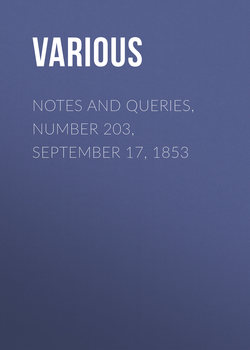Читать книгу Notes and Queries, Number 203, September 17, 1853 - Various - Страница 5
Notes
HERALDIC NOTES
ОглавлениеArms of Granville.—The meaning of the peculiar bearing which, since the thirteenth century, has appertained to this noble family, has always been a matter of uncertainty to heraldic writers: it has been variously blazoned as a clarion, clavicord, organ-rest, lance-rest, and sufflue. The majority of heralds, ancient and modern, term it a clarion without quite defining what a clarion is: that it is meant for a musical instrument (probably a kind of hand-organ), I have very little doubt; for, in the woodcut Mrs. Jameson gives in her Legends of the Madonna (p. 19.) of Piero Laurati's painting of the "Maria Coronata," the uppermost angel on the left is represented as carrying an instrument exactly similar to this charge as it is usually drawn. The date of this painting is 1340. This is probably about the date of the painted glass window in the choir of Tewkesbury Abbey Church, where Robert Earl of Gloucester bears three of these clarions on his surcoat; and upon a careful examination of these, I was convinced that they were intended to represent instruments similar to that carried by the angel in Laurati's painting.
Arms of Richard, King of the Romans.—This celebrated man, the second son of King John, Earl of Cornwall and Poictou, was elected King of the Romans at Frankfort on St. Hilary's Day (Jan. 13th) 1256. His earldom of Cornwall was represented by—Argent, a lion rampant gules crowned or; his earldom of Poictou by a bordure sable, bezantée, or rather of peas (poix) in reference to the name Poictou; and as king of the Romans he is said to have borne these arms upon the breast of the German double-headed eagle displayed sable, which represented that dignity. I do not recollect having seen them under this last form, but I have "made a Note of" several other variations I have met with:—
1. In Dorchester Church, Oxfordshire, in painted glass: Argent, a lion rampant, gules crowned or, within a bordure sable bezantée.
2. On the seal of a charter granted by the earl to the monks of Okeburry: a lion rampant crowned. No bordure.
3. On an encaustic tile in the old Singing-school at Worcester: A lion rampant not crowned, with a bordure bezantée. Another tile has the eagle, single-headed, displayed.
4. Encaustic tiles at Woodperry, Oxfordshire: A row of tiles with the lion rampant, apparently within a bordure, but without the bezants; followed by another row which has the eagle displayed, but not double-headed.
5. On an encaustic tile at Hailes Abbey, Gloucestershire, founded by him: The double-headed eagle only, countercharged.
6. On a tile in the Priory Church of Great Malvern: The double-headed eagle displayed, within a circular bordure bezantée.
7. On a tile which I have seen, but cannot just now recollect where: The double-headed eagle, bezantée, without any bordure.
A curious instance of ex-officio arms added to the paternal coat, occurs on the monument of Dr. Samuel Blythe, at the east end of St. Edward's Church, Cambridge. He was Master of Clare Hall, and in this example his paternal arms—Argent, a chevron gules, between three lions rampant sable—occupy the lower part of the shield, being divided at the fess point by something like an inverted chevron, from the arms of Clare Hall, which thus occupy the upper half of the shield. The date is 1713. Is this way of dividing the arms a blunder of the painter's, or can any of your readers point out a similar instance?
Norris Deck.
